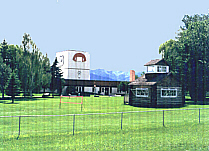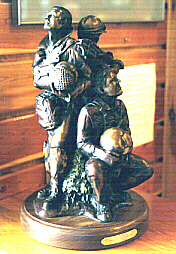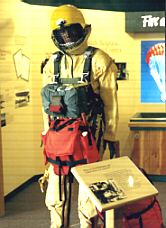Smoke Jumpers Center
Missoula, Montana.
June 27, 1998
 If ever you find
yourself traveling Interstate 90 in western Montana, be sure to
stop by Missoula. A delightful mountain community of around
30,000 with a lot to see. The Clark Fork River runs through the
center of this quaint and friendly town. In the East, the roads
rises to beautiful homes with panoramic views of the city below.
To the south lays Fort Missoula, with it’s museum and
historical transplants, such as the old steam engine pulling
logs, and the train station brought from Drummond.
If ever you find
yourself traveling Interstate 90 in western Montana, be sure to
stop by Missoula. A delightful mountain community of around
30,000 with a lot to see. The Clark Fork River runs through the
center of this quaint and friendly town. In the East, the roads
rises to beautiful homes with panoramic views of the city below.
To the south lays Fort Missoula, with it’s museum and
historical transplants, such as the old steam engine pulling
logs, and the train station brought from Drummond.  However it was in the East,
along US-93 (Reserve St.) that we found the most interesting
story. Sitting some ways back from the road, with it’s white
tower shining with a large parachute emblem, is the U. S.
Department of Forestry’s Smoke Jumpers Center. This is the
first Smoke Jumpers center, created in 1954 as a training,
research, and dispatch center for those adventurous daredevils
who jump out of airplanes, with intentions of extinguishing out
of control forest fires in
However it was in the East,
along US-93 (Reserve St.) that we found the most interesting
story. Sitting some ways back from the road, with it’s white
tower shining with a large parachute emblem, is the U. S.
Department of Forestry’s Smoke Jumpers Center. This is the
first Smoke Jumpers center, created in 1954 as a training,
research, and dispatch center for those adventurous daredevils
who jump out of airplanes, with intentions of extinguishing out
of control forest fires in  inaccessible valleys and mountain
tops. It comes complete with a visitors center, where we met the
delightful Kelly Elliott, a college student majoring in deaf
education, who is holding a summer job. Kelly would be our host
for the next hour as she took us through the training rooms and
work shops, explaining in detail each part of the entire
operation. When
first entering the center, one cannot help but stop to look at
the bronze statue of three smoke jumpers, which sits on the
counter top of the receptionist. Kelly, who’s father is a
fire fighter, explained that the firefighter looking up is a
representation of Firefighter Donald Mackie, a Missoula trained
Smoke Jumper who, along with two others, died while fighting the
Storm King Fire outside Glenwood, Colorado, in 1994. A full
inaccessible valleys and mountain
tops. It comes complete with a visitors center, where we met the
delightful Kelly Elliott, a college student majoring in deaf
education, who is holding a summer job. Kelly would be our host
for the next hour as she took us through the training rooms and
work shops, explaining in detail each part of the entire
operation. When
first entering the center, one cannot help but stop to look at
the bronze statue of three smoke jumpers, which sits on the
counter top of the receptionist. Kelly, who’s father is a
fire fighter, explained that the firefighter looking up is a
representation of Firefighter Donald Mackie, a Missoula trained
Smoke Jumper who, along with two others, died while fighting the
Storm King Fire outside Glenwood, Colorado, in 1994. A full size
representation stands in Glenwood in honor of them. The remainder
of the center is taken up with information boards, displays and a
video about forest fires, and smoke jumpers.
In the middle of the room is a
fully dressed mannequin, ready to jump. Soon Kelly took us to the
“loft” where the actual work is done. We stopped in the
sewing room, as Kelly explained that all the bags and clothing
that goes into making a successful jump, excluding the parachute
itself, is manufactured by the smoke jumpers themselves. We then
went to the chute packing room and saw how the chutes are
actually put into the chute bags. Not all of the 70 or so jumpers
stationed at the center, are certified packers, which is required
to assemble a chute. The chutes come in three different sizes to
complement the various weights of the jumpers. Holes in the
chutes are repaired with lock-stitch nylon, in the sewing room,
by the jumpers themselves.
size
representation stands in Glenwood in honor of them. The remainder
of the center is taken up with information boards, displays and a
video about forest fires, and smoke jumpers.
In the middle of the room is a
fully dressed mannequin, ready to jump. Soon Kelly took us to the
“loft” where the actual work is done. We stopped in the
sewing room, as Kelly explained that all the bags and clothing
that goes into making a successful jump, excluding the parachute
itself, is manufactured by the smoke jumpers themselves. We then
went to the chute packing room and saw how the chutes are
actually put into the chute bags. Not all of the 70 or so jumpers
stationed at the center, are certified packers, which is required
to assemble a chute. The chutes come in three different sizes to
complement the various weights of the jumpers. Holes in the
chutes are repaired with lock-stitch nylon, in the sewing room,
by the jumpers themselves.
